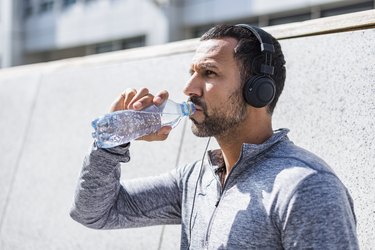
When you're trying to catch some shuteye on a long plane flight next to a crying baby, noise-cancelling headphones are a necessity. They're also essential for drowning out the distracting clank of barbells at the gym. But what about sporting them when you're running outdoors?
If you run on the open road, you need to have situational awareness to stay safe. In other words, you must be aware of what's going on around you — cars, cyclists, pedestrians, animals — and obviously, your ability to hear is a crucial component of that. For instance, you can't dodge an angry dog if you can't hear it barking.
Video of the Day
Video of the Day
If you've been tempted to use your noise-cancelling headphones during a workout, here's how to do it safely.
Tip
While you may want to think twice before wearing your noise-cancelling headphones when running near a busy road, they can work for certain other workouts as long as you keep in mind a few key safety precautions.
First: How Do Noise-Cancelling Headphones Work?
Noise-cancelling headphones reduce unwanted ambient sounds by generating an "anti-noise" sound wave that neutralizes background noise, Andrew Weil, M.D. writes on his website, DrWeil.com. Inside the headphones, a small microphone uses an electronic circuit to pick up low-frequency, long-wavelength sound signals and then produces opposing waveforms to cancel them out. This is called active noise control.
To block the higher-frequency, short-wavelengths from reaching your ears, headphones often use passive noise-cancelling tech such as soundproofing, special materials that reflect or absorb the sound.
Do They Drown Out All Sounds?
Nope. Noise-cancelling headphones can diminish but not totally eliminate external sounds, according to a July 2014 study published in the journal Noise & Health. In fact, the same study found that wearing noise-cancelling headphones helped non-native English speakers hear and distinguish English words more clearly in a noisy environment.
Yet another study, which simulated aircraft cabin noise, showed that using noise-cancelling headphones improved participants' ability to hear and recall safety information, per research published in the January 2013 issue of Safety Science.
So, Are Noise-Cancelling Headphones Safe for Working Out?
Since extremely loud noises can harm hearing, cause headaches and increase blood pressure and stress levels, noise-cancelling headphones can help mitigate some of these negative impacts, according to Dr. Weil.
But whenever you're wearing headphones, noise-cancelling or not, you should always take certain precautions to stay safe, especially when you're engaging in outdoor activities.
Here are some safety tips to keep in mind the next time you take your workout to the street:
- This may seem obvious, but it's easier to hear what's going on around you if your music isn't blasting in your ears. So keep your tunes at a tempered volume.
- When purchasing noise-cancelling headphones, look for ones with "monitor" modes that still allow you to hear background noises. Newer products like Jabra Elite Sport and the Samsung Gear IconX have this special feature, according to Consumer Reports.
- Only wear one earbud while running or exercising outdoors, says running coach John Honerkamp. This way, you'll be able to hear the bus honking or the cyclist saying, "On your right."
- If you're still concerned about safety, save the noise-cancelling headphones for indoor workouts. That doesn't mean you should stomp around the gym obliviously, so keep your volume low to help you avoid any potentially unsafe scenarios.
- Noise & Health: “The effect on recognition memory of noise cancelling headphones in a noisy environment with native and nonnative speakers.”
- Safety Science: “Improving intelligibility at a safety critical point: In flight cabin safety.”
- Consumer Reports: “Headphone Safety Tips: How to reduce risk and safely enjoy your playlists when you’re out and about.”
- Andrew Weil, MD: “Are Noise-Cancelling Headphones Safe?”